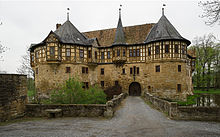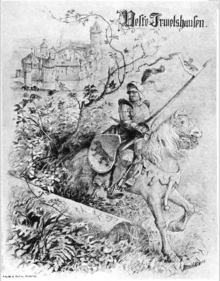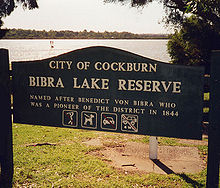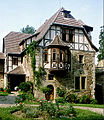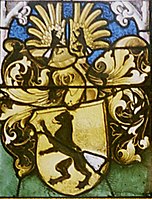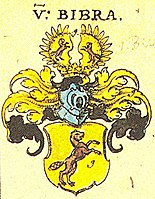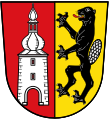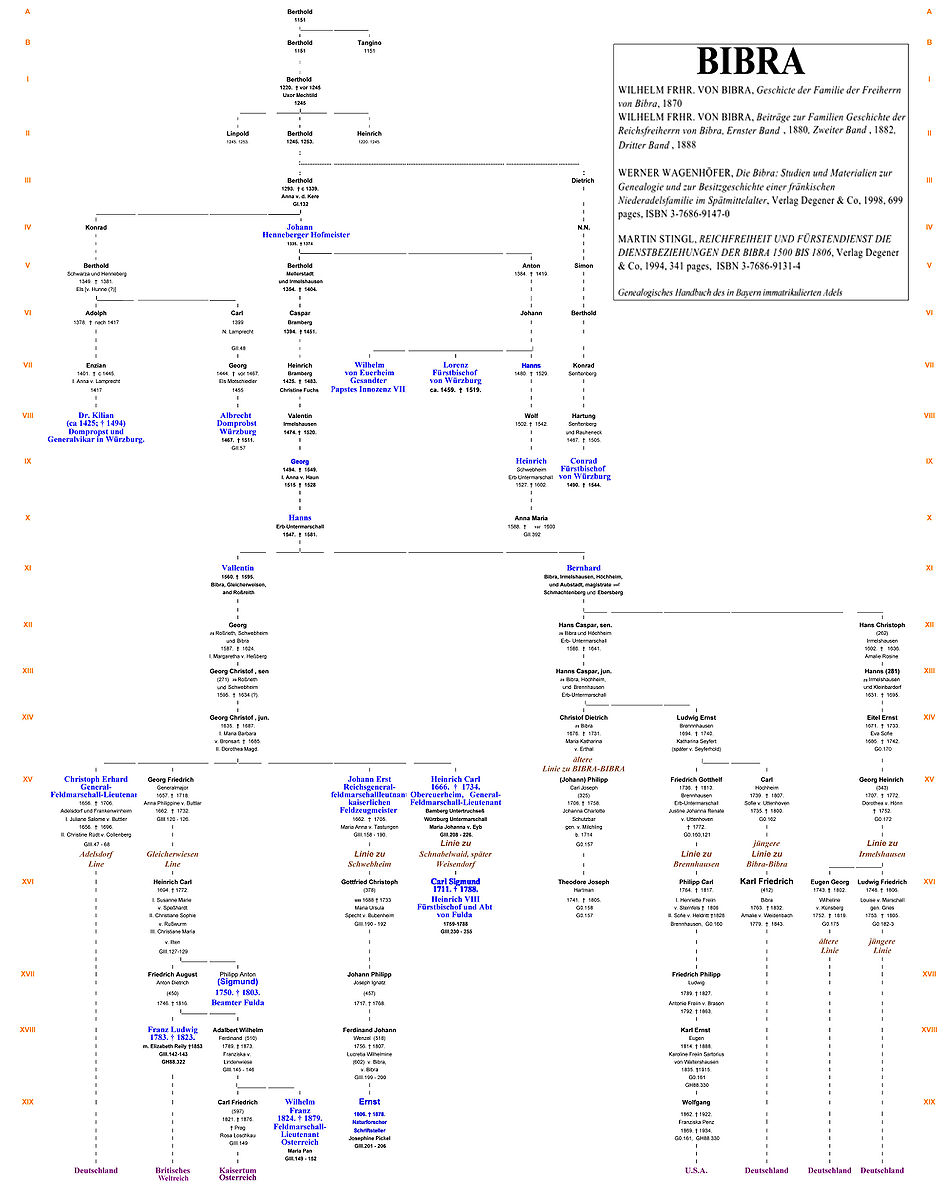Bibra (noble family)
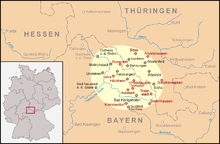
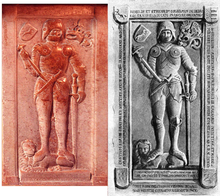

Bibra is the name of a Frankish nobility family . The headquarters of the same name Bibra an der Bibra is today a district of the Grabfeld municipality in the Schmalkalden-Meiningen district in the Free State of Thuringia .
history
In a document from Bishop Otto I of Bamberg from 1119, "Rupertus de Bibra" was named as a witness. "Pertholdus (Berthold) de Bibra" and his sons "Pertholdus (Berthold)" and "Tagino" were mentioned in documents from 1151 onwards. Another "Degenhart de Bibra" witnessed an act by Bishop Hermann von Würzburg in 1234 . In the Würzburg diocese , the family was also given the office of hereditary marshal and in 1375 the knight Hermann von Bibra became hereditary burgomaster of Fulda Abbey at Salzungen Castle .
Emperor Friedrich III. sent Wilhelm von Bibra , whom he had appointed Eques auratus ( knight of the golden spur ), in 1486 and 1490 as envoy to the Vatican . Wilhelm died in Verona in 1490 and was buried in the church of St. Anastasia. His son later erected a monument there in his honor. Lorenz von Bibra was Prince-Bishop of Würzburg from 1495 to 1519 and Konrad von Bibra from 1540 to 1544 . Heinrich von Bibra was prince abbot or bishop of Fulda from 1759 to 1788 .
From the 16th to the 18th century, the Lords of Bibra belonged to the imperial knighthood in the knightly canton of Rhön-Werra of the Franconian knightly circle because of the possession of Gleimershausen (today a district of the Rhönblick community ), Irmelshausen (today a district of the Höchheim community ) and Aubstadt . With the acquisition of Schwebheim and Adelsdorf from the beginning of the 17th century, they were also members of the knight cantons of Steigerwald , Gebürg , Altmühl and Baunach .
The brothers Johann Ernst, Christian Erhard, Georg Friedrich and Heinrich Karl obtained the baron status from Emperor Leopold I through a diploma dated August 3, 1698. Johann Ernst von Bibra died in 1705 as an Imperial General Feldzeugmeister and Lieutenant Field Marshal of the Franconian Empire . The various lines of the sex were entered in the baron class of the Bavarian aristocratic registers in 1815 and in the following years .
distribution
The family property included Bibra near Meiningen . The family was closely associated with the Rohr monastery during the 13th century and with the Veßra monastery in the 14th century . The castles in Bibra , Irmelshausen and Brennhausen are still owned by the family. Irmelshausen and firing Hausen are two of the remarkable surge tanks in Swiss francs and are often shown on calendars and photo books. Burg Bibra is the castle in Thuringia with the longest continuous possession of a family since records began. Many members of the family now live in Australia and the United States.
Family property
- Bibra Castle , Bibra (since around 1100)
- Irmelshausen moated castle (since 1376)
- Brennhausen Castle (since 1681)
- Dörfleshof (between Aubstadt and Ottelmannshausen) (since 1859)
Previous ownership
- Adelsdorf Palace (1687–1993)
- Aschach Castle (1391–1407)
- Aroldshausen (near Jüchsen ) (approx. 1435 – approx. 1990)
- Aubstadt (approx. 1308 – after 1859)
- Bahra (1404–1637?)
- Berkach (Grabfeld)
- Lower Castle (Bibra)
- Bramberg Castle (1393–1483) pledge
- Breuberg ( Welkershausen near Meiningen ) (1779–?)
- Castle Burgwallbach (1489-1681)
- Untereuerheim and Obereuerheim with Euerburg Castle (1480–1687)
- Upper Castle (Bibra Castle) in Euerbach
- Gemünda Castle (near Seßlach ) (1510–1655)
- Geroda (1400-1607)
- Gleicherwiesen (ca. 1356-1850)
- Gleimershausen (16th - 18th century)
- Hallenburg (before 1374-1391)
- Henfstädt (in the Middle Ages)
- Castle estate Höchheim (1356-ca. 1970)
- Kleinbardorf Castle (1413–1687)
- Neubrunn (Thuringia) (1366–1496)
- Oselce Castle (Wosseletz Castle) ( Czech Republic ) (1808-1856)
- Osterburg Castle and half of the Themar Office (1380–1468) pledge
- Rappershausen (proportionally) (around 1488? -1637)
- Rentwertshausen (1372-1511)
- Roßrieth Castle (near Mellrichstadt ) (1438- before 1445) (1589–1681)
- Schnabelwaid Castle (1696–1750)
- Schwarza (1355–1425) pledge
- Schwebheim Castle (1513 – approx. 1958)
- Senftenberg Castle (1426–1484) Lien Castle and Office: Altendorf , Buckenhofen , Buttenheim , Eggolsheim , Friesen , Grub , Kalteneggolsfeld , Kauernhofen , Pautzfeld , Schirnaidel , Seigendorf , Seussling and Stackendorf
- Shrub (Grossenhain) (1749–1755)
- Steinach (1343–) fiefdom and pledge
- Trappstadt Castle (1853 – approx. 1970)
- Trimburg Castle (1375–1412) pledge
- Walldorf (near Meiningen) (1779–1946)
- Wiesen Castle (Seßlach) 1818–1822
- Weisendorf Castle (approx. 1750–1785)
- Veste Wildberg and Amt (with Eyershausen , Großbardorf , Großeibstadt , Großwenkheim , Kleinbardorf , Kleineibstadt , Saal an der Saale , Weektiven , Wülfershausen an der Saale ) (1358 - before 1387) pledge, (? - 1687) fiefdom without an office (?)
- Willershausen Castle (half of 1757–1850)
Picture gallery
Bibra Castle
Headquarters in Höchheim
Schwebheim Castle
Structure of the family
- Valentinian tribe (Lutheran), progenitor: Valentin von Bibra († 1595)
- 1st line: Adelsdorf (formerly Euerheim), progenitor: Christoph Erhard (1656–1706)
- 2nd line: Equally designated, (Evangelical-Anglican); Ancestor: Georg Friedrich von Bibra (1659–1718). The Equally Identified line has lived in Australia since the early 19th century. Is Ausgewandert Franz Ludwig von Bibra (* 1783 in Bamberg, † 1823 in Van Diemen's Land, Tasmania / Australia). Bibra Lake, a suburb of Perth in Western Australia , is named after Benedict von Bibra (* July 8, 1809 in Messina, † February 2, 1884 in Howrah / India), who bought land there in the summer of 1843.
- 3rd line Schwebheim, expired with Ernst (1871–1952) and Hans von Bibra (1873–1955)
- Bernardine tribe, progenitor: Bernhard von Bibra (1562–1609)
- 1st line Brennhausen (Catholic and Evangelical- Presbyterian )
- 2nd line from and to Bibra, (Lutheran); Ancestor: Karl Friedrich von Bibra (1739–1807)
- 3rd line Irmelshausen, (Lutheran); Ancestor: Hanns Christoph von Bibra (1602–1636)
- 3rd line, 1st older branch, 1st branch
- 3rd line, 1st older branch, 2nd branch, progenitor: August Wilhelm (1775–1844). Extinguished with Berthold von Bibra (1902–1944), fallen
- 3rd line, 2nd younger branch, progenitor: Ludwig Friedrich von Bibra (1748–1806)
coat of arms
The family coat of arms shows a soaring black beaver with a red tongue and a silver-scaled tail in gold. On the (crowned) helmet are two wings repeating the shield symbol with beavers facing inwards. The helmet cover is black and gold.
Historical coats of arms
Coat of arms of the Lords of Bibra in the St. Leo Church in Bibra
Coat of arms in Siebmacher's coat of arms book , 1605
Coat of arms graphic by Otto Hupp in the Munich calendar from 1916
Coat of arms associated with the von Bibra family
Several municipal coats of arms in Thuringia and Lower Franconia remind of the gender. Due to the controversy over the inclusion of the beaver from the Bibra coat of arms, the acceptance of a municipal coat of arms for Schwebheim failed in 1983 .
Coat of arms of the former municipality of Bibra
Coat of arms of the municipality of Adelsdorf
Coat of arms of the municipality of Höchheim
Coat of arms of Gleicherwiesen
Aubstadt coat of arms
Coat of arms of Steinach an der Saale
Name bearer
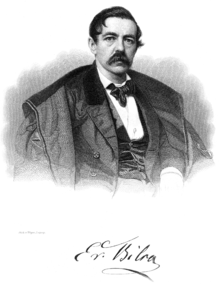
- Albrecht von Bibra († 1511), Würzburg (cathedral provost 1502) and Bamberg canon
- August von Bibra (1775–1844) , German Jägermeister and politician
- August von Bibra (1808–1894) , German treasurer and court official
- August von Bibra (1818–1878) , German forester and politician
- Bertold von Bibra (* 1804; † 1878), forester and member of the state parliament
- Carl Friedrich Wilhelm Gottlob von Bibra (* 1770; † 1842), farmer and politician
- Christian Ernst Heinrich von Bibra (* 1772, † 1844), real privy councilor, land hunter master , bearer of the Grand Cross from the Hessian order of Philip the Magnanimous
- Christoph Erhard von Bibra (* 1656; † 1706) October 12, 1704 Imperial Field Sergeant, May 2, 1705 Lieutenant General Field Marshal Mainz
- Ernst von Bibra (* 1806; † 1878), natural scientist and writer
- Heinrich von Bibra (* 1711; † 1788), Prince-Bishop and Abbot of Fulda
- Heinrich Karl von Bibra (Karl Siegmund) (* 1666; † 1734), head of the Franconian district (March 10, 1713) and Bamberg (June 28, 1730), Lieutenant General Field Marshal, father Heinrich Prince-Bishop and Abbot of Fulda, first owner of the Bibra Palais (also Bibra House) in Bamberg, expansion under Johann Dientzenhofer
- Johann Ernst von Bibra (* 1662; † 1705) April 12, 1701 Imperial Field Marshal Lieutenant , May 11, 1704 Lieutenant General Field Marshal , May 20, 1704 Imperial Feldzeugmeister
- Kilian von Bibra (* around 1425, † 1494), vicar general of the Würzburg prince-bishop
- Conrad III. von Bibra (* 1490; † 1544), Würzburg Prince-Bishop and Duke in Franconia
- Lorenz von Bibra (* 1459; † 1519), Würzburg Prince-Bishop and Duke in Franconia
- Nikolaus von Bibra (* 1st quarter of the 13th century; † after 1307), he wrote the Occultus Erfordensis from 1281 , an important source for the history of Erfurt in the late 13th century
- Siegmund von Bibra (Philipp Anton von Bibra; since his profession in 1768 Siegmund von Bibra; * 1750; † 1803), German senior civil servant and writer
- Wilhelm von Bibra (* 1442; † 1490), ( Eques auratus ) , envoy of Pope Innocent VIII.
- Wilhelm Franz von Bibra (* 1824; † 1879) April 23, 1878 Lieutenant Field Marshal in the Austro-Hungarian Army
See also
- Bibra (disambiguation)
- List of Frankish knight families
- List of Thuringian knight families
- List of the Würzburg canons
- List of the Bamberg canons
- Fusilier battalion from Bibra with Captain Wilhelm von Dörnberg
literature
- Otto Hupp : Munich Calendar 1916. Munich / Regensburg Publishing House 1916.
- Michael Müller: Prince-Bishop Heinrich von Bibra and the Catholic Enlightenment in the Fulda Monastery (1759–88). Change and continuity of church life. 451 pp., Fulda 2005.
- Werner Schultheiß: Bibra, barons of. In: New German Biography (NDB). Volume 2, Duncker & Humblot, Berlin 1955, ISBN 3-428-00183-4 , p. 215 f. ( Digitized version ).
- Martin Stingl: Imperial Freedom and Princely Service: The Service Relationships of Bibra 1500 to 1806 . Neustadt ad Aisch: Degener 1994 (publications of the Society for Franconian History. Series IX; 41) pp. 238–239.
- Marina von Bibra: Henry VIII - Prince-Bishop of Fulda. In: Gerhard Pfeiffer (Ed.), Fränkische Lebensbilder, Vol. 4, Würzburg 1971, 213–229.
- Wilhelm Freiherr von Bibra: History of the family of the Freiherrn von Bibra. 1870.
- Wilhelm Freiherr von Bibra: Contributions to the family history of the imperial barons of Bibra. (BD. 1), 1880; (BD. 2) , 1882; (BD. 3), 1888 . Digitized edition of the University and State Library Düsseldorf
- Werner Wagenhöfer: The Bibra: Studies and materials on genealogy and ownership history of a Franconian lower nobility family in the late Middle Ages. Verlag Degener & Co, 1998; ISBN 3-7686-9147-0 .
- Werner Wagenhöfer: The burial of the lower nobility in late medieval Franconia - the example of the Bibra , economy - society - mentalities in the Middle Ages , commemorative publication for the 75th birthday of Rolf Sprandel, Franz Steiner Verlag, Stuttgart, 2006 ISBN 3-515-08882-2 , ISBN 978 -3-515-08882-4 , pp. 335-359.
- The nobility enrolled in Bavaria, Volume 8, pages 158-180, published in 1964
- The nobility enrolled in Bavaria Volume 13, pages 311–335, ISBN 3-7686-5050-2
- Gerhard Friedrich Albrecht : Genealogical state calendar on the year MDCCLXXVI . Frankfurt / M. 1776, pp. 15-25 ( full text )
Individual evidence
- ↑ Schwebheimer Amtsbote 1983, pp. 39–41, 43–45, 50, 92, 101–102, 114, 174
- ↑ https://www.mainpost.de/regional/schweinfurt/Adelsgeschlecht-Biber-Heraldik-Stadtraete-und-Gemeinderaete;art763,8000932
- ↑ cf. List of regiments of the Frankish Reichskreis
Web links
- Werner Wagenhöfer: Bibra, noble family . In: Historical Lexicon of Bavaria
- www.vonbibra.net
- Entry about Bibra in New General German Nobility Lexicon
- Coat of arms of the family of Bibra
- Wappenbuch Bertschi, Nikolaus: Wappenbuch - BSB Cod.icon. 308 , Augsburg 1515-1650
- Bibra's coat of arms in the Book of Arms of the Holy Roman Empire , Nuremberg around 1554–1568
- The one from Bibra in Kleinbarsdorf at welt-der-wappen.de
- Google Book The market town of Bibra 1892


